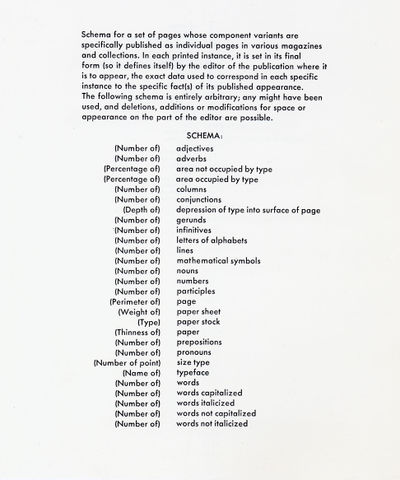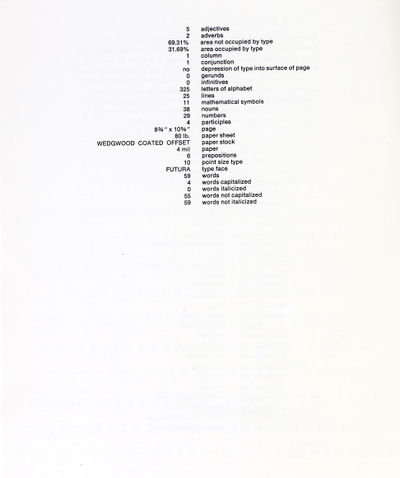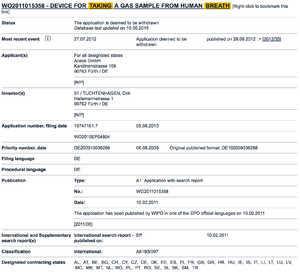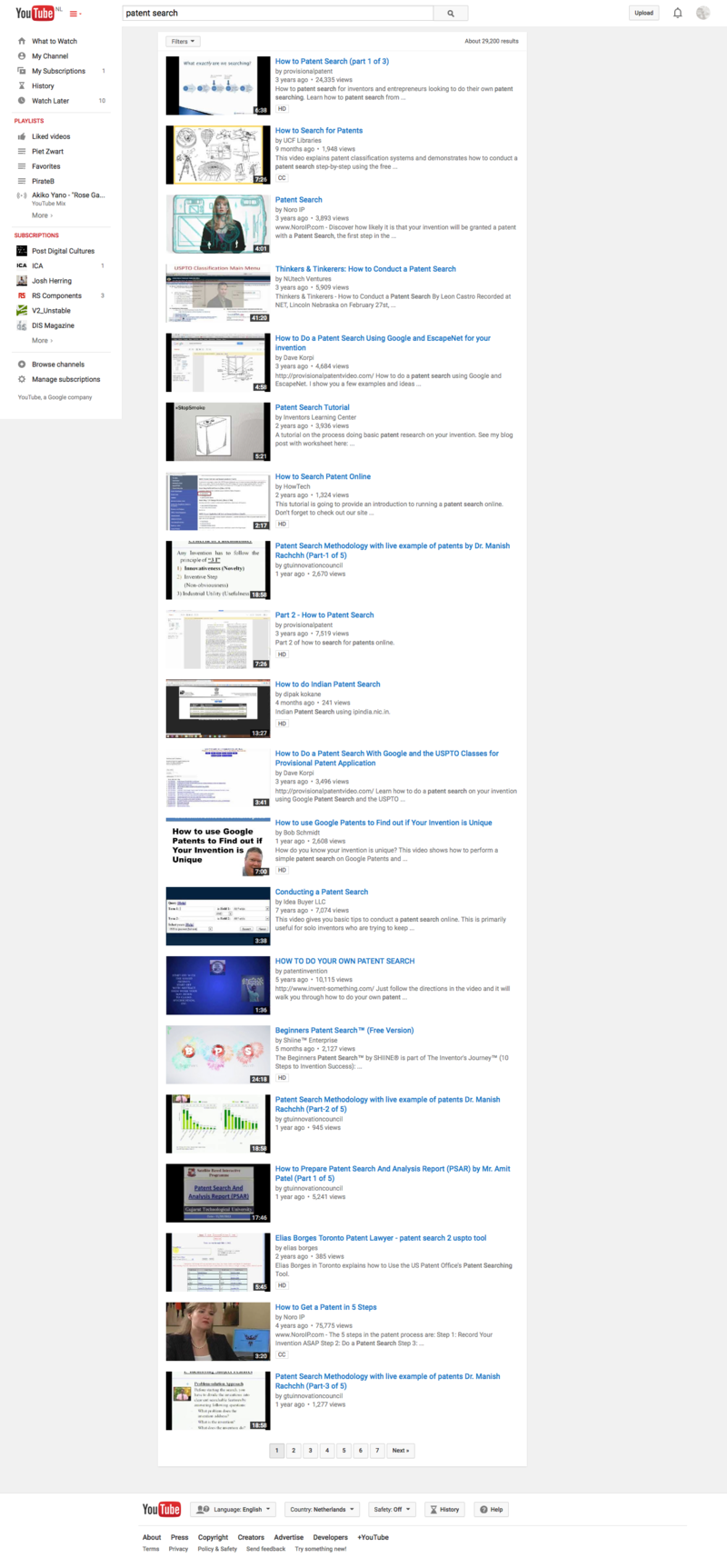User:Cristinac/thirdobject: Difference between revisions
No edit summary |
No edit summary |
||
| (11 intermediate revisions by the same user not shown) | |||
| Line 1: | Line 1: | ||
<div style="width: | <div style="width:1000px"> | ||
<u>Dan Graham, Poem Schema</u> | <u>Dan Graham, Poem Schema</u> | ||
| Line 31: | Line 30: | ||
*[http://www.gnu.org/philosophy/not-ipr.en.html Richard Stallman: The term “intellectual property” is at best a catch-all to lump together disparate laws. Nonlawyers who hear one term applied to these various laws tend to assume they are based on a common principle and function similarly. Nothing could be further from the case. These laws originated separately, evolved differently, cover different activities, have different rules, and raise different public policy issues. ] | *[http://www.gnu.org/philosophy/not-ipr.en.html Richard Stallman: The term “intellectual property” is at best a catch-all to lump together disparate laws. Nonlawyers who hear one term applied to these various laws tend to assume they are based on a common principle and function similarly. Nothing could be further from the case. These laws originated separately, evolved differently, cover different activities, have different rules, and raise different public policy issues. ] | ||
*[http://www.csmonitor.com/2000/0801/p7s2.html 'A Moscow company has thrown Russian businesses - breweries especially - into tumult by successfully patenting "glass containers," including the lowly bottle.'] | |||
*[http://pdfpiw.uspto.gov/.piw?docid=08676045&PageNum=1&IDKey=E46BB9438AC7&HomeUrl=http://pdfpiw.uspto.gov/ Amazon patents the studio arrangement] | *[http://pdfpiw.uspto.gov/.piw?docid=08676045&PageNum=1&IDKey=E46BB9438AC7&HomeUrl=http://pdfpiw.uspto.gov/ Amazon patents the studio arrangement] | ||
*[http://www.google.com/patents/licensing/ Google is announcing an experiment to remove friction from the patent market and improve the landscape: The Patent Purchase Promotion. Starting May 8, 2015 and continuing through May 22, 2015, we will open a streamlined portal for patent holders to tell Google about patents they are willing to sell.] | |||
<u>I have a friend whose mother is working at OFICIUL DE STAT PENTRU INVENŢII ŞI MĂRCI (OSIM), the patenting office in Romania. I've recently sent her an email asking about details of her job: </u> | |||
| Line 59: | Line 64: | ||
''Imi cer scuze ca intrebarile sunt atat de generale, inca nu am gasit un unghi asupra subiectului prin care as putea sa il privesc, dar as vrea sa aflu mai mult despre asta! | ''Imi cer scuze ca intrebarile sunt atat de generale, inca nu am gasit un unghi asupra subiectului prin care as putea sa il privesc, dar as vrea sa aflu mai mult despre asta! | ||
''Va multumesc | ''Va multumesc. | ||
''O seara buna, | ''O seara buna, | ||
| Line 105: | Line 108: | ||
#'''Evil media vs. [http://www.yoha.co.uk/node/646 grey media] | |||
[[File:exciting.png|300px]][[File:breathtaking.png|300px]][[File:amazing.png|300px]] | |||
Baudrillard-Why Hasn't Everything Already Disappeared? | |||
[http://www.seobythesea.com/2011/07/google-acquires-ibm-patents-in-july/ Google acquires IBM patents in July] | |||
'''From 'Patent Absurdity': | |||
#''US Patent Act Amendment, July 19, 1952: along with "machine", "manufacture" or "composition of matter", a "process" is included as patentable statutory subject matter | |||
#''Gottschalk vs Benson, Supreme Court, 1972: Respondent's method for hexadecimal conversion merely a series of mathematical calculations or mental steps and does not constitute a patentable "process" within the meaning of the Patent Act | |||
#''Diamond vs Diehr, Supreme Court, March 3, 1981: The working of a machine is patentable, whether it is controlled by a human or a computer | |||
#''In re Lowry, Federal Circuit, August 26, 1994: The data structure of a computer's hard drive constitutes a "machine" that is eligible for patentability | |||
#''State Street vs Signature Financial, Federal Circuit, July 23, 1998: A numerical calculation that produces a "useful, concrete and tangible result", such as a price, is patent-eligible | |||
'''[http://web2.wipo.int/ipcpub/#refresh=page International Patent Classifications:] | |||
The IPC divides technology into eight sections with approximately 70,000 subdivisions. Each subdivision has a symbol consisting of Arabic numerals and letters of the Latin alphabet. | |||
*''Section A: Human Necessities | |||
*''Section B: Performing Operations, Transporting | |||
*''Section C: Chemistry, Metallurgy | |||
*''Section D: Textiles, Paper | |||
*''Section E: Fixed Constructions | |||
*''Section F: Mechanical Engineering, Lighting, Heating, Weapons, Blasting | |||
*''Section G: Physics | |||
*''Section E: Electricity | |||
'''[http://www.uspto.gov/web/patents/classification/selectnumwithtitle.htm United States Patent Classifications:] | |||
*''too many to list here | |||
<u>[http://en.swpat.org/wiki/How_to_read_patents How to read patents (specifically software patents)]</u> | |||
'''29,200 hits on youtube for videos advising you on how to perform a patent search: | |||
[[File:Patent_search.png|800px]] | |||
<u>[http://nighthacks.com/roller/jag/entry/quite_the_firestorm the quest for the silliest application] | |||
[https://www.lhup.edu/~dsimanek/museum/patents.htm Patents for unworkable applications] | |||
[http://uk.businessinsider.com/inside-ibms-patent-creation-machine-2015-3?r=US Master inventors at IBM. That's a special title at the company for someone who has lots patents and helps other ordinary employees do the same.] | |||
[http://www.ft.com/cms/s/2/0780e2ee-f4cb-11e4-8a42-00144feab7de.html Unitary European Patenting system]</u> | |||
<i>patent changelings</i> | |||
<u>Non-Assertion Pledge: 500 patents from IBM (2005) and 245 currently from Google/ Patent Commons</u> | |||
<u>[http://cs.stanford.edu/people/eroberts/cs201/projects/communism-computing-china/intelproperty.html Patent Law in Early Communist China] | |||
[http://www.nettime.org/Lists-Archives/nettime-l-0208/msg00122.html page ranking, not really related, but interesting] | [http://www.nettime.org/Lists-Archives/nettime-l-0208/msg00122.html page ranking, not really related, but interesting] | ||
</div> | </div> | ||
Latest revision as of 12:24, 15 June 2015
Dan Graham, Poem Schema
- «Schema for a set of pages whose component variants are to be published in various places. In each published instance, it is set in its final form by the editor of the particular publication where it is to appear, the exact data used to correspond in each specific instance to the specific fact(s) of the published final appearance. The work defines itself in place only as information with simply the external support of the facts of its external appearance or presence in print in place of the object.» (March 1966) (Source: Dan Graham, Art-Language, vol. 1 no 1, May 1969, p. 14, repr. in: Dan Graham, Works 1965–2000, Düsseldorf 2000, p. 95)
patent or be patented:
From: "ova.kill" <mezandwalt {AT} wollongong.starway.net.au>
Date: Wed, 02 Aug 2000 13:52:35 +1000
In-Reply-To: <20000729173432.8156.qmail {AT} nwcst315.netaddress.usa.net>
What is a patent?
a government grant to an inventor of the right to exclude others from making, using, or selling an invention, usually for a limited period. Patents are granted for new and useful machines, manufactured products, and industrial processes and for significant improvements of existing ones. Patents also are granted for new chemical compounds, foods, and medicinal products, as well as for the processes used to produce them. In some countries patents can be granted even for new forms of plant or animal life developed through genetic engineering. (from Encyclopedia Britannica)
I have a friend whose mother is working at OFICIUL DE STAT PENTRU INVENŢII ŞI MĂRCI (OSIM), the patenting office in Romania. I've recently sent her an email asking about details of her job:
Buna ziua doamna Andrei,
Sunt o prietena de-a Anei, ma numesc Cristina. Nu sunt sigura daca a avut ocazia sa va spuna ceva despre mica mea investigatie. Momentan lucrez la un proiect despre brevete de inventie in cadrul primului an de master in design de media. Subiectul ma intereseaza din mai multe motive, cum ar fi propagarea cunoasterii - in ce masura sustin brevetele inovatia, interventia statului asupra inventiilor, dar si conditia retorica pe care o sustin, fiind scheme ale unui potential obiect al carui statut -existent/inexistent- este indeterminat.
Daca considerati ca timpul va permite si nu va deranjeaza sa raspundeti la cateva intrebari pe care le voi enumera mai jos, mi-ar fi de mare ajutor discutia.
Ati putea va rog sa-mi explicati in masura implicarii dumneavoastra in procesul de verificare al brevetelor, in ce consta?
In engleza exista termenul de "patent troll", cu referire la companii care isi creeaza un portofoliu de brevete cu scopul de a aduce in instanta inventatori neinformati despre existenta lor. Intampinati astfel de cazuri des?
In continuarea intrebarii de mai sus, ati intalnit o exprimare intentionat vaga pentru a indeplini cat mai multe cerinte? Sau un aplicant a carui exprimare este notabila?
Este procesul de verificare a brevetului diferit in Romania de cel din strainatate?
Au existat cazuri in care produsul brevetat nu a fost niciodata pus in aplicatie si a ramas la nivel de concept?
Imi cer scuze ca intrebarile sunt atat de generale, inca nu am gasit un unghi asupra subiectului prin care as putea sa il privesc, dar as vrea sa aflu mai mult despre asta!
Va multumesc.
O seara buna,
Cristina
the reply was:
Bună ziua,
Subiectul este destul de vast şi voi încerca să răspund punctual întrebărilor puse. Intre "invenţie" şi "inovaţie" există o diferenţă. Invenţia este soluţia unei probleme tehnice care apare la un moment dat într-un anumit domeniu pe care cunoştinţele existente la acea dată în domeniul respectiv nu o pot rezolva.
Inovaţia este aplicarea invenţiei.
#Brevetul de invenţie susţine inovaţia prin aceea că îi asigură titularului dreptul exclusiv de exploatare pe toată durata sa (20 de ani). Un brevet de invenţie poate fi cesionat sau poate face obiectul vânzării unei licenţe către un terţ. Conform legislaţiei în vigoare (Legea 64 republicată în MO 613 în 19.08.2014) Guvernul României prin intermediul OSIM recunoaşte drepturile unei invenţii pe teritoriul României prin acordarea unui brevet de invenţie. Pentru ca o cerere de brevet de invenţie să poată deveni brevet de invenţie trebuie să îndeplinească, cumulativ, anumite criterii, respectiv să fie nouă, să aibă activitate inventivă şi aplicabilitate industrială.
#Activitatea de examinare a unei cereri de brevet de invenţie are două etape:
##examinarea preliminară când se examinează dacă cererea de brevet de invenţie întruneşte cerinţele juridice; şi
##examinarea de fond (eu) când se examinează dacă soluţia tehnică pe care o susţine cererea de brevet de invenţie îndeplineşte cele trei criterii de brevetabilitate menţionate anterior.
#Termenul de "patent troll" fiind un termen peiorativ nu este utilizat în limbajul uzual al brevetelor în acest caz există termenul "infingement" care înseamnă încălcarea drepturilor conferite de brevet de către o persoană care nu are aceste drepturi (terţ). Titularul brevetului poate cere daune materiale în cazul în care consideră şi dovedeşte în instanţă că aceste drepturi i-au fost încălcate. Aceste încălcări sunt relativ frecvente mai ales în anumite domenii (farmaceutic, telecomunicaţii, etc.) şi nu puţine sunt procesele deschise de anumite firme împotriva celor care le încalcă drepturile.
#Conform legii întinderea protecţiei este dată de modul în care este revendicat obiectul invenţiei. În general solicitantul are tendinţa de a solicita o întindere cât mai mare pentru brevetul său şi, da există uneori exprimări de acest gen. Dacă protecţia solicitată nu este susţinută de descrierea invenţie şi de exemplele de realizare atunci protecţia este limitată la ceea ce este demonstrat.
#Deoarece OSIM este membru cu drepturi depline al Oficiului European de Brevete (EPO sau OEB) legislaţia noastră este acordată cu legislaţia impunsă de Convenţia Brevetului European, dar există câteva mici diferenţe (de ex., spre deosebire de OEB care conferă protecţie pentru o nouă utilizare a unui produs în românia această protecţie este acordată în general doar pentru utilizările din domeniul medical).
#Da,este cazul din păcate al brevetelor obţinute de persoanele fizice sau chiar de persoane juridice care fie nu doresc decât un punctaj ceva mai mare pentru a accesa fonduri europene fie doresc doar o blocare a unor anumite sectoare. Acestea sunt aşa numitele brevete de sertar sau de ramă. În general se doreşte ca un brevet să nu rămână la acest nivel dar nu ştiu dacă există anumite motivaţii, eventual financiare, care să impulsioneze pe titularul unui brevet să-l aplice el sau să-l cesioneze unui terţ în vederea aplicării de către acesta. Sper că am reuşit să răspund, cel puţin parţial întrebărilor tale. Pentru o ma bună informare eistă legislaţia în domeniu sau mă poţi contacta şi în limita celor ştiute de mine îţi pot răspunde.
O zi bună,
Ana Andrei
- Evil media vs. grey media
Baudrillard-Why Hasn't Everything Already Disappeared?
Google acquires IBM patents in July
From 'Patent Absurdity':
- US Patent Act Amendment, July 19, 1952: along with "machine", "manufacture" or "composition of matter", a "process" is included as patentable statutory subject matter
- Gottschalk vs Benson, Supreme Court, 1972: Respondent's method for hexadecimal conversion merely a series of mathematical calculations or mental steps and does not constitute a patentable "process" within the meaning of the Patent Act
- Diamond vs Diehr, Supreme Court, March 3, 1981: The working of a machine is patentable, whether it is controlled by a human or a computer
- In re Lowry, Federal Circuit, August 26, 1994: The data structure of a computer's hard drive constitutes a "machine" that is eligible for patentability
- State Street vs Signature Financial, Federal Circuit, July 23, 1998: A numerical calculation that produces a "useful, concrete and tangible result", such as a price, is patent-eligible
International Patent Classifications:
The IPC divides technology into eight sections with approximately 70,000 subdivisions. Each subdivision has a symbol consisting of Arabic numerals and letters of the Latin alphabet.
- Section A: Human Necessities
- Section B: Performing Operations, Transporting
- Section C: Chemistry, Metallurgy
- Section D: Textiles, Paper
- Section E: Fixed Constructions
- Section F: Mechanical Engineering, Lighting, Heating, Weapons, Blasting
- Section G: Physics
- Section E: Electricity
United States Patent Classifications:
- too many to list here
How to read patents (specifically software patents)
29,200 hits on youtube for videos advising you on how to perform a patent search:
the quest for the silliest application
Patents for unworkable applications
Unitary European Patenting system
patent changelings
Non-Assertion Pledge: 500 patents from IBM (2005) and 245 currently from Google/ Patent Commons







